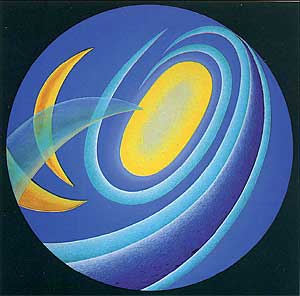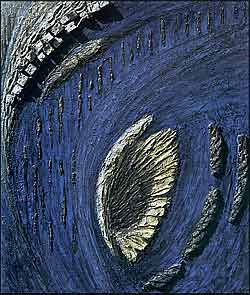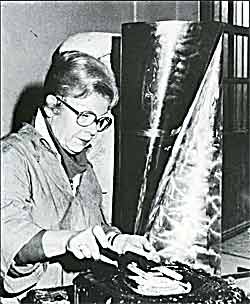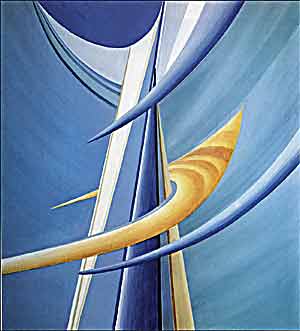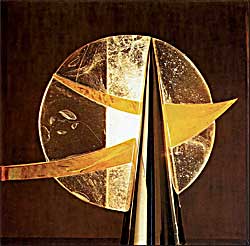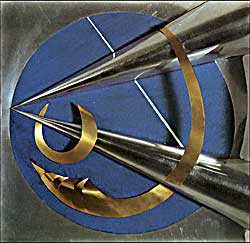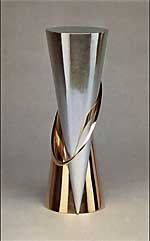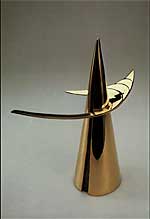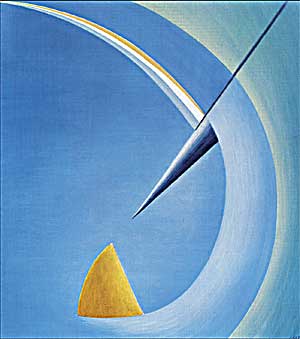|
Pianeta C[1].S.70, 1986
Scultura luminosa, 1970
Cesarina Seppi, 1972
Messaggio, 1969
"Bundles of light, diagonal cones, the points of stars cross an intensely blue sky. The artist calls these images "messages". I believe that this is a desire still experienced by all creatures, the desire for a word that deciphers the secrets of existence. Man climbs the infinite sky, but feels the need to question the ultimate purpose of his existence in the immensities. After all, artists have always and at all times grappled with this threshold. Cesarina does so with a clarity of ideas that also renders this hope more convincing to all of us". (Marco Valsecchi 1969)
Messaggio, 1969
In 1977, the artist created a series of sculptures entitled "hourglasses", in which the idea of the hourglass, staggered as two approaching cones, becomes dominant and acquires further possibilities of interpretation. This is a double entendre, in which one can see either a reference to time as dramatically interrupted, or, quite to the contrary, the peaceful resumption of its flow. scultura luminosa, acciaio inox, 1970
composizione, 1970 scultura luminosa, acciaio inox, 1970
trappola per il sole, 1978
|
This interview illustrates the adventure of the image as creator treasured by the artist: more than places of truth, Seppi constructs moments of poetry.
It is not time that passes
The artist tends to incessantly perfect and discard her precarious creations, she observes her new work without certainties about its future destiny. One plays with time, appropriates it, transforms the variegated world of forms, colours and sounds offered by our surroundings to construct parallel universes and access the recesses of creation. I perceive the passage of time most when darkness descends; it is then that I listen to the silence, but I am missing the light of day. The end of creativity can find solace in the autonomous life that can continue for the works already produced, independently from their authors. Creativity engenders further creativity, it is a stimulus and a vibration achieved only in a moment of pleasure. In February 2003, you inaugurated your sculpture Lunar Flower (Fiore lunare) in Piazza Cesare Battisti in Trento. You donated this work to the city in memory of the Tridentine poet Marco Pola. I executed the work in memory of Marco Pola, poet and engraver, who did a lot for Tridentine artists in the 20th century, after the war. I remember him at the time when we used to meet at the Circle of the Blue Pony (Circolo del Cavallino Azzurro) and he used to write and draw on the large stone tables. The sculpture is made of CorTen, I wanted to experiment with a new material. Poetry is exploding above, below is humanity; a tension that lives in a kind of expression which seeks neither to indicate nor to describe, but to declare a presence. It is reaching out to those places where our inner voices speak to us, every one of them alone with its own universe of figures, not so much a voice but unspoken thoughts, conceived and assimilated in time, in reflection. It is here that the trust in imagination originates, a contribution of aesthetic fiction, a possible and difficult opportunity to always fall in love with the present. It was an important goal after two years of hard work, to and fro from Verona, achieved through sheer dedication and effort, but all troubles were happily overcome in the determination to offer something to the community, to my people, a symbol, a testimony of this presence which is always alive in our Tridentine history. On the occasion of the inauguration, you thanked the many friends of this mountainous land and the voice of the mountains. What did this voice suggest to you? The most significant memories of my life are bound up with the mountains. All the forms I create come from the mountains. I have interpreted the mountains my way, like a character; I battled to understand them, I had to climb them, tread the ground underfoot. Since I was little, I loved to collect the strangest stones, the fossils you can find in the Dolomites around Cortina d'Ampezzo, such as megalodonts, often set in the massive banks of these rocks and in the detrital layers at the base of the rock faces. They testify to a process of creation that is still so alive and tangible. I was enchanted by the imposing pinnacles of the Tridentine mountains, by the glaciers, by the crystal-clear springs. When I see a mountain in front of me, it is the mountain that dominates, alive and mysterious, enchanting me by cladding itself in the colours of different seasons. All sculptures, including Lunar Flower, have the mountains as their point of departure. What are the expressive necessities from which you developed a study of light? Among your works, we remember "First lights" (Prime luci) and "Chronicle of a landscape" (Cronaca di un paesaggio). What techniques did you experiment with? It was born from an entirely internal exigency, a need to find
the world in order to exalt the internal chromatic resonances,
thus making them independent from the conditions of ambient
lighting, isolating them from it and recreating their soul.
Light penetrates the elements around us, moves through and beyond
them; it is not only a visual trajectory, but also an auditory
one, it involves the entire emotional being, all senses become
mixed up in it. It was the necessity to repropose, through the
sum of its refractions, that brightness which I could glimpse
between the larches, between the firs with their branches outlined
against the light. I needed to penetrate space, rock faces,
rocks through the light, to structure figures with light. I
was always interested in experimenting with all techniques and
materials to deepen and enrich my artistic expression, from
painting to mosaics and stained glass. In 1965, I carried out
my first work in metal, using bas-relief and a mixture of techniques
with aluminium and brass. Then, from the beginning of the 1970s,
I moved on to sculptures in stainless steel, coloured collages
of polished glass, illuminated from the inside, and bronze sculpture. You have always been very attentive to the needs of your city. What does the artistic commitment mean to you? It lies within the competence of the poet, the artist to deepen the human question in all its forms, and this is expressed in directing one's spirit towards, in this sense, having a potential capacity to change the world. It is the mountains that continue to provide the message. I have tried to transmit it by trying to interpret them.
Messaggio, 1969 |
© 2006-2007 EcodelleDolomiti

